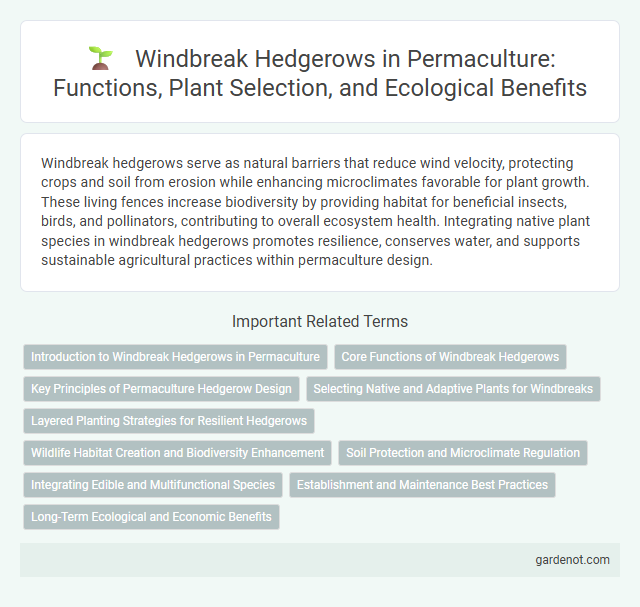Windbreak hedgerows serve as natural barriers that reduce wind velocity, protecting crops and soil from erosion while enhancing microclimates favorable for plant growth. These living fences increase biodiversity by providing habitat for beneficial insects, birds, and pollinators, contributing to overall ecosystem health. Integrating native plant species in windbreak hedgerows promotes resilience, conserves water, and supports sustainable agricultural practices within permaculture design.
Introduction to Windbreak Hedgerows in Permaculture
Windbreak hedgerows are essential elements in permaculture design, serving to reduce wind speed, prevent soil erosion, and create microclimates that enhance plant growth. Incorporating diverse species with varying heights and densities promotes biodiversity while providing habitat for beneficial insects and wildlife. Strategic placement around gardens and fields optimizes protection, increases crop yields, and supports sustainable land management.
Core Functions of Windbreak Hedgerows
Windbreak hedgerows serve essential functions by reducing wind speed, which protects crops from wind damage and minimizes soil erosion. They enhance microclimates by moderating temperature extremes and conserving soil moisture, promoting healthier plant growth. These hedgerows also provide habitat for beneficial wildlife, supporting biodiversity and natural pest control within permaculture systems.
Key Principles of Permaculture Hedgerow Design
Windbreak hedgerows in permaculture optimize microclimates by reducing wind speed and conserving soil moisture, which enhances crop productivity and biodiversity. Strategic plant selection incorporates diverse species for multiple functions, including nitrogen fixation, habitat provision, and food production, aligning with permaculture's emphasis on multifunctionality. Proper spacing and layering ensure effective airflow management while maximizing ecological benefits and resilience against environmental stressors.
Selecting Native and Adaptive Plants for Windbreaks
Selecting native and adaptive plants for windbreak hedgerows enhances ecosystem resilience by supporting local wildlife and optimizing growth conditions. Species such as Eastern Red Cedar, American Holly, and Switchgrass thrive in various climates while providing effective wind reduction and soil stabilization. Utilizing deeply rooted, drought-tolerant plants improves long-term sustainability and reduces maintenance requirements in permaculture systems.
Layered Planting Strategies for Resilient Hedgerows
Layered planting strategies in windbreak hedgerows enhance ecological resilience by combining tall trees, mid-story shrubs, and groundcover plants to create multi-tiered barriers against wind erosion. This vertical diversity improves habitat complexity, supports beneficial wildlife, and stabilizes soil structure while maximizing microclimate benefits. Utilizing species such as nitrogen-fixing shrubs and deep-rooted perennials promotes soil fertility and water retention, driving sustainable permaculture practices.
Wildlife Habitat Creation and Biodiversity Enhancement
Windbreak hedgerows serve as critical wildlife habitats by providing shelter, nesting sites, and food sources for diverse species, thereby enhancing local biodiversity. These multi-layered plantings create microclimates that support pollinators, birds, and beneficial insects while reducing soil erosion and wind damage to adjacent crops. Integrating native shrubs and trees in permaculture designs fosters resilient ecosystems and promotes ecological balance.
Soil Protection and Microclimate Regulation
Windbreak hedgerows play a crucial role in soil protection by reducing wind erosion and maintaining soil moisture levels in permaculture systems. Their dense vegetation acts as a natural barrier, preventing topsoil loss and enhancing soil fertility through organic matter accumulation. By moderating wind speed and creating a stable microclimate, these hedgerows improve plant growth conditions and increase biodiversity in agricultural landscapes.
Integrating Edible and Multifunctional Species
Windbreak hedgerows in permaculture are designed by integrating edible and multifunctional species such as berry-producing shrubs, nut trees, and nitrogen-fixing plants to enhance biodiversity and soil fertility. These species provide food, habitat for beneficial insects, and protection against wind erosion while improving microclimates for adjacent crops. Selecting native and drought-tolerant plants maximizes resilience and ecosystem services within the permaculture system.
Establishment and Maintenance Best Practices
Establishing a windbreak hedgerow involves selecting native, drought-tolerant species with deep root systems to enhance soil stabilization and ensure long-term resilience. Regular pruning and mulching maintain plant health, improve wind resistance, and promote biodiversity by providing habitat for beneficial insects and birds. Soil moisture monitoring and timely irrigation during dry periods optimize growth and prevent stress, supporting the hedgerow's protective function in permaculture systems.
Long-Term Ecological and Economic Benefits
Windbreak hedgerows improve soil health by reducing erosion and enhancing moisture retention, leading to increased agricultural productivity over time. They provide habitat for beneficial wildlife and pollinators, promoting biodiversity that supports ecosystem resilience. Economically, these hedgerows lower energy costs by serving as natural wind barriers and reduce crop damage, contributing to sustainable farm profitability.
Windbreak hedgerow Infographic

 gardenot.com
gardenot.com